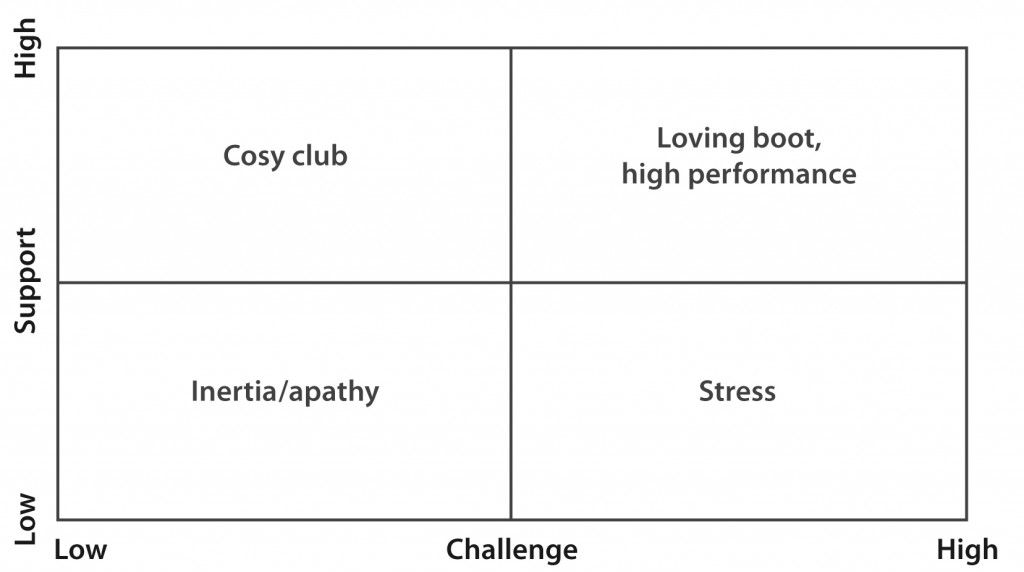It was an uncomfortable moment. I was conducting a coaching demonstration as part of a challenging coaching workshop. Around five minutes into the coaching, my volunteer from the audience told me the topic they had chosen was not a real issue; it was something they had made up. I paused and realised that, in terms of the support / challenge matrix below, I was at a moment of choice.
On the one hand, I could head for the comfort of the ‘apathy’ quadrant of the support / challenge matrix. In that low challenge, low support mode, I could shrug my shoulders and say, ‘Ok, It’s only a demonstration, let’s carry on’. On the other hand, I could remember that this was intended to be a demonstration of challenging coaching skills and I could head for the high challenge / low support frontier and enter the ZOUD (zone of uncomfortable debate).
Though the stakes were high, due to the public nature of the session, I drew a deep breath and said calmly, ‘The agreement I had with the group was that someone would bring a real topic to this coaching session. I feel you’ve disregarded that agreement and, as a result, this coaching demonstration is not going to deliver the value we were hoping it would’. A spike of tension shot into the room with this statement and I felt a knot in the pit of my stomach. I looked at my coachee and noticed that he was smiling. It was a smile that said, ‘At last, someone has held me to account’. Equally calmly, he replied, ‘I understand. So let me tell you about the real issue…’ He then proceeded to share a sensitive challenge which had been giving him sleepless nights. Based on his reaction to the challenge, I now knew he was a robust and confident individual. The tension quickly dissipated and we appeared to have suddenly struck up a healthy mutual respect.
So much so that some minutes later I hit another moment of choice and, again, I dived into the ZOUD with the following intervention, ‘Can I give you some challenging feedback?’. ”Yes, go ahead’. ‘I have noticed that the issue you have shared involves you struggling to share information openly with your boss. Earlier in the session, you also struggled to share information openly with me. What is this telling us?’. This time a longer silence, no smile and the same spike of tension in the room. ‘OK, I get it’ my coachee reluctantly concluded.
As the session drew to a close, a final moment of choice appeared. I shifted to the low challenge, high support quadrant and said, ‘You’re a brave guy. You must be brave to come up here and share this topic with us all. What’s more, you handled my challenges extremely well. You are confident and determined to succeed. I am equally confident that you are going to take action on this issue and that you have the strength to see it through successfully. Thank you for becoming so committed to this work’.
Following a brief spell of action-setting, we ended the demonstration. It had taken all of thirteen minutes, yet I felt drained and unsettled by the turn of events. Reflecting on the situation later, I was reminded that it is never comfortable to enter the zone of uncomfortable debate, particularly in public! However much we might practise or develop our skills, there is always a new ‘cliff edge’ approaching. There has to be, otherwise how do we keep sharpening the saw? How do we stay at the top of our game?
We encounter new moments of choice in every coaching session and we decide to head for a particular quadrant of the support / challenge matrix. Sometimes we pull, sometimes we push. Sometimes we are full of care, sometimes we confront. Sometimes it is safe, sometimes it is edgy. Sometimes we get it right, sometimes we get it wrong. All we know is that the day we stop taking risks then probably our clients stop taking risks too. And without taking calculated risks how will we, and they, achieve our courageous goals? As the American writer, Ray Bradbury, famously said, ‘You’ve got to jump off cliffs all the time and build your wings on the way down’.
It was an uncomfortable moment. I was conducting a coaching demonstration as part of a challenging coaching workshop. Around five minutes into the coaching, my volunteer from the audience told me the topic they had chosen was not a real issue; it was something they had made up. I paused and realised that, in terms of the support / challenge matrix below, I was at a moment of choice.
On the one hand, I could head for the comfort of the ‘apathy’ quadrant of the support / challenge matrix. In that low challenge, low support mode, I could shrug my shoulders and say, ‘Ok, It’s only a demonstration, let’s carry on’. On the other hand, I could remember that this was intended to be a demonstration of challenging coaching skills and I could head for the high challenge / low support frontier and enter the ZOUD (zone of uncomfortable debate).
Though the stakes were high, due to the public nature of the session, I drew a deep breath and said calmly, ‘The agreement I had with the group was that someone would bring a real topic to this coaching session. I feel you’ve disregarded that agreement and, as a result, this coaching demonstration is not going to deliver the value we were hoping it would’. A spike of tension shot into the room with this statement and I felt a knot in the pit of my stomach. I looked at my coachee and noticed that he was smiling. It was a smile that said, ‘At last, someone has held me to account’. Equally calmly, he replied, ‘I understand. So let me tell you about the real issue…’ He then proceeded to share a sensitive challenge which had been giving him sleepless nights. Based on his reaction to the challenge, I now knew he was a robust and confident individual. The tension quickly dissipated and we appeared to have suddenly struck up a healthy mutual respect.
So much so that some minutes later I hit another moment of choice and, again, I dived into the ZOUD with the following intervention, ‘Can I give you some challenging feedback?’. ”Yes, go ahead’. ‘I have noticed that the issue you have shared involves you struggling to share information openly with your boss. Earlier in the session, you also struggled to share information openly with me. What is this telling us?’. This time a longer silence, no smile and the same spike of tension in the room. ‘OK, I get it’ my coachee reluctantly concluded.
As the session drew to a close, a final moment of choice appeared. I shifted to the low challenge, high support quadrant and said, ‘You’re a brave guy. You must be brave to come up here and share this topic with us all. What’s more, you handled my challenges extremely well. You are confident and determined to succeed. I am equally confident that you are going to take action on this issue and that you have the strength to see it through successfully. Thank you for becoming so committed to this work’.
Following a brief spell of action-setting, we ended the demonstration. It had taken all of thirteen minutes, yet I felt drained and unsettled by the turn of events. Reflecting on the situation later, I was reminded that it is never comfortable to enter the zone of uncomfortable debate, particularly in public! However much we might practise or develop our skills, there is always a new ‘cliff edge’ approaching. There has to be, otherwise how do we keep sharpening the saw? How do we stay at the top of our game?
We encounter new moments of choice in every coaching session and we decide to head for a particular quadrant of the support / challenge matrix. Sometimes we pull, sometimes we push. Sometimes we are full of care, sometimes we confront. Sometimes it is safe, sometimes it is edgy. Sometimes we get it right, sometimes we get it wrong. All we know is that the day we stop taking risks then probably our clients stop taking risks too. And without taking calculated risks how will we, and they, achieve our courageous goals? As the American writer, Ray Bradbury, famously said, ‘You’ve got to jump off cliffs all the time and build your wings on the way down’.






